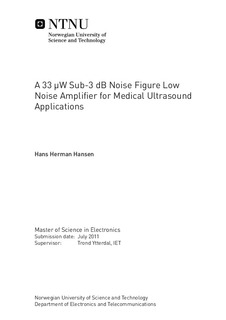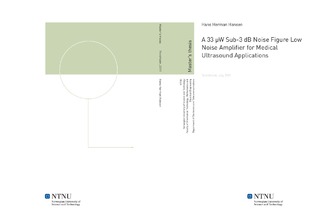| dc.description.abstract | The low noise amplifier is a critical part of most high performance ultrasoundreceivers, and is important for achieving high sensitivity and a wide dynamic range.By having a large gain in the low noise amplifier, the total noise of the receiversystem will be dominated by that of the amplifier. For most low noise amplifier,there is a fundamental trade off between accuracy and power consumption, whichmakes it difficult to design micro power front end amplifiers with excellent noiseperformance. In some cases, however, lower accuracy can be tolerated if the sourceitself is noisy. This is the case for small, high impedance sources, where the noiselevel is in the region of 18 nV/sqrt{Hz}.This thesis presents the design and simulations of a low noise amplifier instandard 180 nm CMOS suitable for use with high impedance sources. In fact,high impedance sources pose challenges on the biasing of voltage amplifiers,where maintaining high input impedance is necessary. In addition, for differentialamplifiers, implementing common mode feedback will typically result in a significantincrease in power consumption and area overhead. To alleviate this problem, aswitched common mode feedback scheme is implemented, that also provide highinput impedance biasing of the input transistors.In order to cope with the large dynamic range requirement inherent in manyultrasound modalities, variable gain is often used to compress the dynamic rangefor the analog front end. Methods for adding variable gain without resulting in alarge increase in area and power consumption is therefore of huge interest in manyultrasound applications. Several methods of adding variable gain is investigated inthis thesis, and a capacitive attenuator is proposed, which causes minimum increasein noise factor, while increasing the gain range by at least 20 dB.Large scale integration of several thousands analog front ends in a singleultrasound probe handle requires low power consumption and minimum areaoverhead for all parts of the analog front end, including the low noise amplifier.By using a figure of merit based optimization technique, the designed amplifiertopology achieves an low power consumption of 17.3 μA, while maintaining a noisefactor of less than 3 dB at resonance. In addition to performing a single ended todifferential conversion, this amplifier realizes a maximum voltage gain of 23.4 dB,with a 3 dB bandwidth of 21.5 MHz. | nb_NO |

